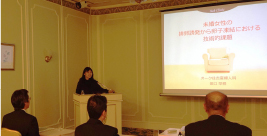

We made a presentation at the meeting.
"Technical Challenges in Fertility to Oocyte Freezing in Unmarried Women"
(Sagiri Taguchi)
We made a presentation at the conference.
「Comparison of 3 types of sperm freezing and thawing techniques」
(Louise Kate Young、Sagiri Taguchi, Terumi Hayashi, Miyako Funabiki, Yoshihiro Tada, Masako Karita, Yuri Iwaki, Yoshitaka Nakamura)
We made a presentation at the conference.
[The effect of time between semen collection and swim-up on the fertilization and blastocyst rate during conventional IVF]
(Miyako Funabiki, Sagiri Taguchi, Terumi Hayashi, Yoshihiro Tada, Yuri Iwaki, Masako Karita, Yoshitaka Nakamura)
Prevalence of chronic endometritis in repeated unexplained implantation failure and the IVF success rate after antibiotic therapy, Ettore Cicinelli, Itay, Human Reproduction, Vol.30,No.2 pp.323-330, 2015
Of the 256 cases of repeated implantation failure between 2009- and 2012-or those who did not have implant even after returning 11 or more well-formed embryos, 106 cases excluding obesity factors and male factors were analyzed.
The procedure is to first diagnose suspicion of chronic endometritis (CE) with a hysteroscope and then diagnose CE with histology.
Of the 70 people diagnosed with suspected CE by hysteroscope, 61 were diagnosed with CE by histology.
Bacterial culture of tissues diagnosed with CE resulted in 45% being positive.
When antibiotics were administered to those who were diagnosed with CE by histological examination, the implantation rate and childbirth rate within 6 months after treatment improved significantly between the cured group and the non-cured group.
In other words, hysteroscopy is the first effective way to find CE in people with repeated non-implantation.
And when CE was diagnosed by histological examination, it was a paper that proved oral antibiotics were effective.
At our hospital, we also use hysteroscopy to diagnose the presence or absence of chronic endometritis in people with repeated non-implantation, and administer antibiotics if necessary.
In addition, even if there is no inflammation, the implantation rate increases for several cycles with endometrial regeneration. (Excerpt)
Letters from Patients
❖Thank you from the bottom of my heart for the baby born on March 10th.
I'm full of happiness now, even though my treatment period was so difficult.
When I was about to get sick during the treatment, I thought I couldn't have a baby at all for sure, and but the doctor encouraged me and I was able to do my best.
Also, when I was treated late at night due to a sudden imminent miscarriage, even though was so anxious, everyone was kind to me and I could press on.
The eggs that the embryologist carefully raised have grown so large.
Thank you very much to everyone.
We will take good care of our children, who have been cherished by many people.
I would like to visit you again. At that time, thank you.
A research group at the Graduate School of Pharmaceutical Sciences, the University of Tokyo has clarified the detailed three-dimensional structure of three patterns of fertilization-related proteins: "Izumo" on the sperm surface, "Juno" on the egg surface, and a complex of both.
As a result, it is possible to understand the interaction between sperm and egg, and it is expected to help develop contraceptives with a new mechanism of action that does not use hormones.
It will inhibit the binding between Izumo and Junho. On the other hand, the process of membrane fusion may involve structural changes in the complex and unknown molecules, and more detailed research on the mechanism is required.
Studies such as measuring these molecules are thought to be useful in infertility treatment.
From January to February this year, the Ministry of Health, Labor and Welfare research group conducted a questionnaire on male infertility on the Internet, and received responses from 333 men and women.
297 people underwent a semen test.
Nearly 30% of the tested people had "zero or close to zero sperm" and about 10% said "almost no problem".
The participants were asked when the male partner had his tests done.
116 (42%) said they had it at the same time as the woman's test, and 129 said "after the woman had her tests" (47%) and 28 (10%) answered that the male partner had his tests first.
About half of them started the test with females first.
The cause of infertility is 50% for men and 50% for men.
The research group says, "The later you notice the cause, the longer the period of fertility treatment will be.
When you start treatment, be sure to have tests together.

| Interests | Music |
|---|---|
| Hobbies | SCUBA diving |
| Motto | Do what you have to do |
| Message |
We nurses are the ones who meet everyone in the outpatient department and are the contact points for various things.
|